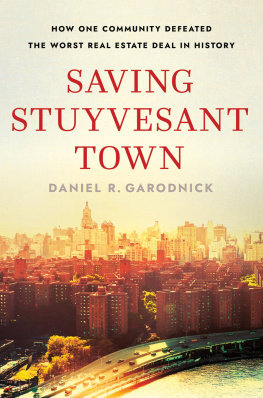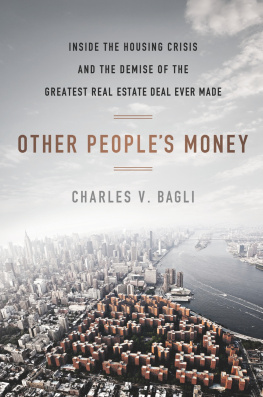ACKNOWLEDGMENTS
First and foremost, I want to thank my neighbors in Peter Cooper Village and Stuyvesant Town, and the board and volunteers of the citys fiercest Tenants Association that simply refused to give up. They were the best possible partners in fighting this most unusual battle, and worked with good humor and steely resolve. Thanks to Al Doyle, for his calm strength, to John Marsh, for his passion and energy, and to Susan Steinberg, for her smarts and humor in difficult times. Longtime resident John Sheehy joined us midway through and helped to bring critical insights and direction to the discussion. Soni Fink passed away before this book was published. Her wit and strength of character kept us focused, and I was grateful for her friendship. And thanks to Steven Sanders, who grew up in Stuy Town, became its assemblyman, and continues to always be a thoughtful and devoted supporter of our community. Each of them not only was a leader in this journey but also was very helpful in making sure that I told this story accurately.
My friends Julie Ehrlich and Steven Newmark agreed to join the Tenants Association board at my urging and threw themselves wholeheartedly into the cause, devoting countless hours and significant brainpower over many years. And, of course, colorful and passionate longtime resident John Crotty put lots of big ideas in my headand then gave me the critical tools to execute them.
I was fortunate to have a very talented city council staff over twelve years. I am endlessly grateful to them for their devotion to our constituents and for keeping me sane throughout. Many of them were involved in the Stuy Town saga, including Justine Almada, who literally walked three miles in the snow for her job interview, and was my first liaison to Stuy Town; Andrew Sullivan, my city council campaign manager and first chief of staff; Marianna Vaidman Stone, who showed up to help me on every single difficult land-use project that I encountered over twelve years; Dan Pasquini, who headed our early communications team; David Kimball-Stanley, who was my district chief of staff; and Ilona Kramer, who started as an intern and returned to become my chief of staff. Thanks as well to Gretchen Kruesi, Grace Phillipp, Anicka Kolarik, Priom Ahmed, Shayla Mars, Emma Lowe, Matt Scanlan, Lily Mandlin, Tim Laughlin, Elena Aarons, and Howie Levine, all of whom fielded hundreds of calls from Stuy Town residents with every complaint you could imagine. And to Ellen Gustafson, who for years smoothly helped me to move through my day and made it look easy.
Special recognition to my chief of staff and friend Genevieve Michel, the brass-knuckled Californian who for five years was my chief adviser and partner in all matters, including the race to be city council speaker (though its still too bad she doesnt know how to drive). She was, and is, an important sounding board for me, and was also gracious enough to be one of the early readers of this book.
Thank you to Sabina Mollot and Chris Hagedorn of Town & Village newspaper, for allowing me to bury myself in the archives of the papers headquarters in New Rochelle for research. And extra thanks to Sabina for going through her own finicky computer to identify useful photos.
I want to express my appreciation to William Kelly and the late Marie Beirne, who spent considerable time interviewing Stuy Town residents on video and allowed me to view the rough footage. Thank you to Sherry Glied, dean of NYU Wagner School, for hosting me as a Visiting Scholar and giving me the space to focus, and to my Hunter College Grove Scholars Juan Cambeiro, Isidora Echeverria, Florimond Le Goupil-Maier, and Nicole Retsepter, who helped with some early research.
Meredith Kane, Alex Kornberg, and Brian Hermann of Paul Weiss, and Alex Rubin and Bill Derrough of Moelis & Company were instrumental in our efforts. They took enormous risks, personal and professional, to support the Stuy Town tenants, and never wavered in their commitment to the cause. Id also like to thank Paul Weiss in particular, for giving me great training as a lawyer and then supporting every professional effort that I have ever undertaken. That of course includes my friend Andrew Ehrlich, who served as my campaign treasurer, best man at my wedding, and who has been with me every step of this journey.
Thank you to everyone I interviewed for this book, whose names and quotes appear throughout. I enjoyed reliving the events with you. Thanks also to Janette Sadik-Khan, Paul Elie, and Harold Holzer for helping me to develop my initial proposal and get it off the ground, and to Rohit Aggarwala for his early guidance. With much appreciation to Peter McGuigan, my agent at Ultra Literary, who knew just the right moment to break out the tequila; to my editor Michael McGandy for recognizing the importance of this story; and to the team at Cornell University Press, including Clare Kirkpatrick Jones, Ashley Julia Britts, Karen Hwa, and Brock Edward Schnoke.
I am very lucky to have some wonderful friends who were willing to jump in as turbo proofreaders at the eleventh hour, when my bleary eyes could no longer see words. Jesse Johnston, Tania Brief, Marianna Vaidman Stone, Sigal Mandelker, Jean Weinberg, Michael Woloz, and Jeff Waldyou went above and beyond, and for that, I am incredibly grateful. You are the best.
Thank you to my friend Jean Manas, for giving me so much unsolicited guidance over the yearsincluding encouraging me to write a book. I was bound to take your advice at some point.
To my mom and dad, Barbara and David Garodnick, who gave me everything I needed for success in life. They filled me with strength and confidence, and always worked to find ways to reduce my stress. They were just about the best parents that anyone could hope for. I miss my mom very much, and suspect that she would have loved that her son actually wrote a book. My dad continues to be by my side, cheering me on and firmly believing that I would be the winner in any political office for which I might ever run, at any level.
I am incredibly grateful for my two dynamic sons, Asher, who is empathetic and wise beyond his years, and Devin, who is filled with creativity and determination. These boys bring me lifes greatest joy, and their presence reminds me every day about what really matters.
And for my incredibly talented, smart, thoughtful wife, Zoe, who read this book more times than she reasonably had time to do, gave me brutally honest feedback, and is my very best friend and editor: I love you very much. This would not have happened without you.
ACTIVISM FROM THE START
You cant miss the wall of redbrick buildings that emerges out of the East Village on Manhattans East Side. The plain and unenticing facades of Stuyvesant Town and Peter Cooper Village carefully disguise the unique slice of city life that takes place within. Just inside, flower beds bursting with tulips line the paths connecting the buildings, sunbathers sprawl on lush grassy areas, and children play in fifteen well-maintained playgrounds. Young families come together for picnics on the lawn, teenagers fill the basketball courts, and elderly New Yorkers sit on benches, passing the day.
Its idyllic quality belies the tumultuous history that produced this middle-class enclave tucked in the midst of Manhattan. In reality, the history of Stuyvesant Town is anything but idyllic. Born of government-backed, and subsidized, racist policies and the displacement of poor New Yorkers, Stuyvesant Towns roots are planted in bitter soil. But the history of Stuyvesant Town is punctuated by something else, too, which is deeply woven into the fabric of the community. From its earliest days, the story of Stuyvesant Town is also one of activism, where elected officials, civil rights leaders, and tenants joined together to fightand in most cases ultimately winagainst corporate greed and unjust policies, and for the rights of New Yorkers.













